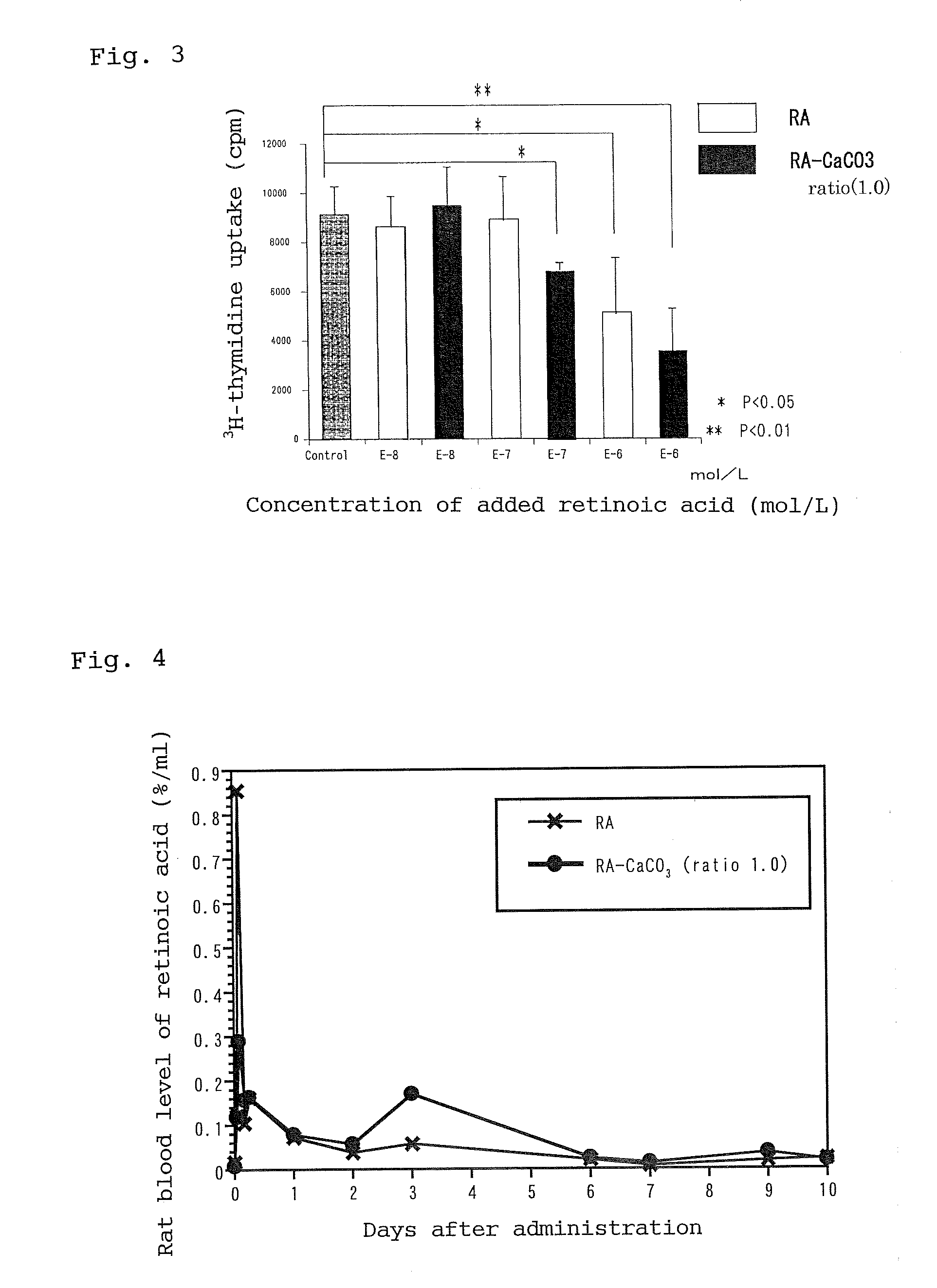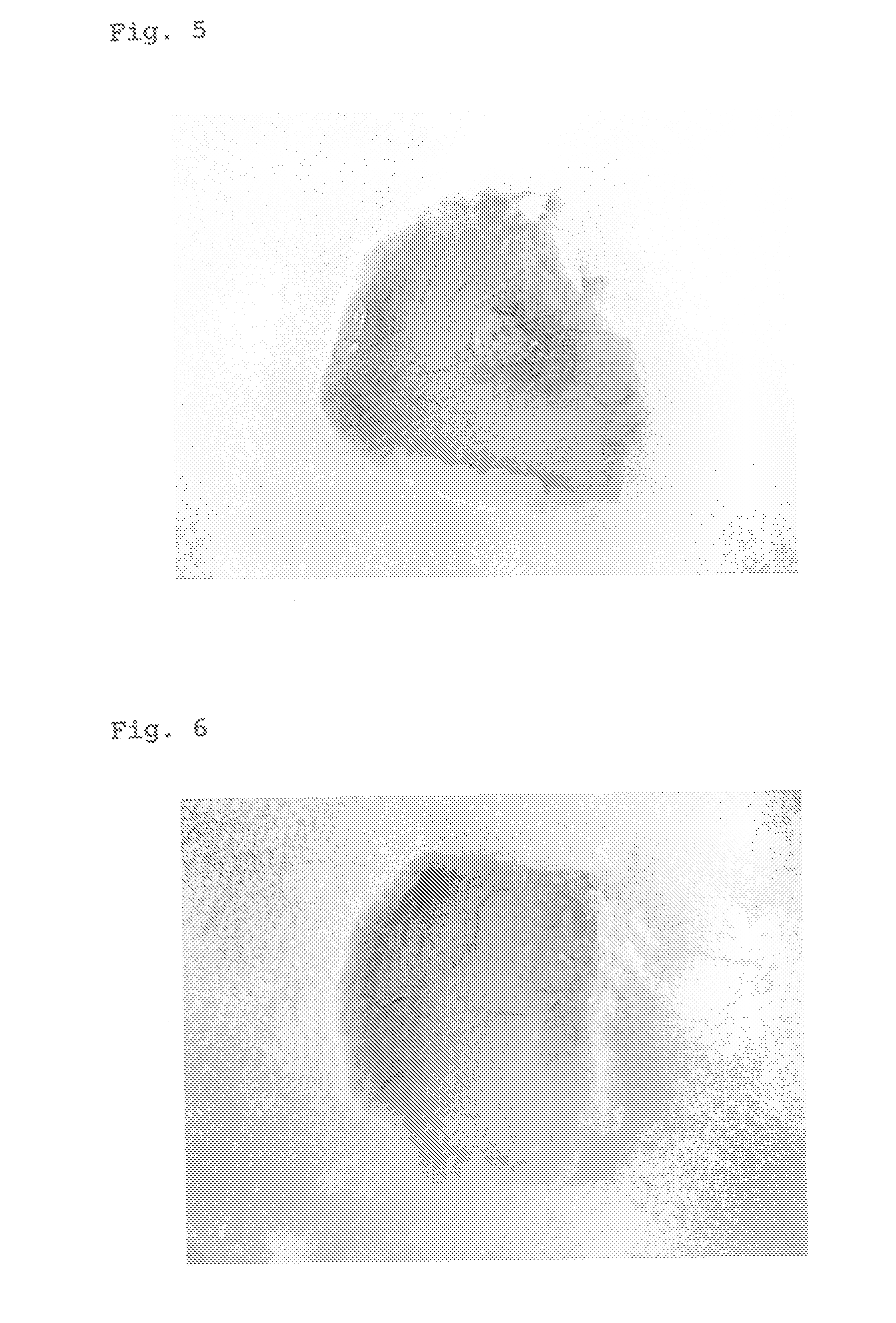Method of controlling paticle size of retinoic acid nanoparticles coated with polyvalent metal inorganic salt and nanoparticles obtained by the controlling method
Inactive Publication Date: 2007-01-18
NANOEGG RES LAB
View PDF3 Cites 12 Cited by
- Summary
- Abstract
- Description
- Claims
- Application Information
AI Technical Summary
Benefits of technology
[0007] The previously proposed retinoic acid-containing nanoparticles are prepared in the following manner: Retinoic acid dissolved in a small amount of a polar solvent is dispersed in alkali-containing water. To this dispersion, a nonionic surfactant is added to form mixed micelles, to which a salt of divalent metal is added, followed by a salt that can form negative divalent ion. This gives the desired product.
[0008] The retinoic acid-containing nanoparticles so prepared comprise particles that have a coating of a metal compound deposited on the surface thereof. For example, when the salt of divalent metal is calcium chloride and the salt that can form negative divalent ion is sodium carbonate, a coating of calcium carbonate is deposited on the surface of nanoparticles.
[0009] The retinoic acid-containing nanoparticles previously provided by the present inventors are prepared by taking advantage of the amphipathic property of retinoic acid. Specifically, retinoic acid is first dispersed in an aqueous solution to form spherical micelles having negatively charged surface. A nonionic surfactant and then calcium chloride are added to allow calcium ion (Ca2+) to adsorb onto the negatively charged micelle surface. This prevents aggregation and subsequent precipitation of retinoic acid micelles and gives spherical or oval micelles covered with calcium ions. Sodium carbonate is then added to allow carbonate ion (CO32−) to adsorb onto (bind to) the calcium ion-coated micelle surface and thus completely neutralize the s
Problems solved by technology
However, retinoic acid has irritancy due to carboxyl groups present in the molecule and, when subcutaneously administered, causes inflammation or tumor formation at the site of injection.
Moreover, the high solubility of retinoic acid in lipids makes it difficult to formulate the compound into injections.
Nonetheless, the strong irritancy of retinoic acid, a common property of carboxylic acids, causes inflammation and other skin problems, making the compound unsuitable for use in
Method used
the structure of the environmentally friendly knitted fabric provided by the present invention; figure 2 Flow chart of the yarn wrapping machine for environmentally friendly knitted fabrics and storage devices; image 3 Is the parameter map of the yarn covering machine
View moreImage
Smart Image Click on the blue labels to locate them in the text.
Smart ImageViewing Examples
Examples
Experimental program
Comparison scheme
Effect test
 Login to View More
Login to View More PUM
| Property | Measurement | Unit |
|---|---|---|
| Size | aaaaa | aaaaa |
| Particle size | aaaaa | aaaaa |
| Nanoscale particle size | aaaaa | aaaaa |
Login to View More
Abstract
Nanoparticles containing retinoic acid have reduced irritancy of retinoic acid and are suitable for subcutaneous or intravenous administration, as well as for use in sustained-release preparation. The high skin permeability of the nanoparticles makes them suitable for use in pharmaceutical or non-pharmaceutical external preparations or cosmetics intended for skin application. The present invention provides a method for adjusting the particle size of such nanoparticles and nanoparticles produced by such a method. Specifically, the method involves dispersing retinoic acid dissolved in a lower alcohol in an aqueous alkali solution; adding a nonionic surfactant to the dispersion to form a mixed micelle; adding to the micelle a halide or acetate of divalent metal along with a carbonate or phosphate of alkali metal so that the molar ratio of the former to the latter is 1:0 to 1:1.0, thereby depositing a coating of inorganic salt of polyvalent metal on the surface of the micelle; and adjusting the average particle size of the resulting nanoparticles to 5 to 300 nm. The inorganic salt of polyvalent metal may be calcium carbonate, zinc carbonate, or calcium phosphate.
Description
TECHNICAL FIELD [0001] The present invention relates to a method for adjusting the particle size of retinoic acid nanoparticles coated with an inorganic salt of polyvalent metal. More particularly, the present invention relates to a method for adjusting the particle size of retinoic acid nanoparticles coated with an inorganic salt of polyvalent metal, such as calcium carbonate, zinc carbonate, or calcium phosphate, as well as to nanoparticles obtained by the method. BACKGROUND ART [0002] Retinoic acid, a liposoluble vitamin A acid, has recently attracted much attention for its ability to induce differentiation of embryonic stem (ES) cells and various other undifferentiated cells. Retinoic acid has been clinically used as a cure for acute promyuelocytic leukemia. [0003] However, retinoic acid has irritancy due to carboxyl groups present in the molecule and, when subcutaneously administered, causes inflammation or tumor formation at the site of injection. Moreover, the high solubility...
Claims
the structure of the environmentally friendly knitted fabric provided by the present invention; figure 2 Flow chart of the yarn wrapping machine for environmentally friendly knitted fabrics and storage devices; image 3 Is the parameter map of the yarn covering machine
Login to View More Application Information
Patent Timeline
 Login to View More
Login to View More IPC IPC(8): A61K9/14A61K31/203A61K9/51A61K47/02
CPCA61K9/1075A61K9/5089A61K47/02A61K9/5192A61K31/203A61K9/5115A61P3/02A61P35/02A61P43/00B82B3/00B82Y15/00G01N27/00
Inventor YAMAGUCHI, YOKOIGARASHI, RIEMIZUSHIMA, YUTAKATAKENAGA, MITSUKO
Owner NANOEGG RES LAB
Features
- R&D
- Intellectual Property
- Life Sciences
- Materials
- Tech Scout
Why Patsnap Eureka
- Unparalleled Data Quality
- Higher Quality Content
- 60% Fewer Hallucinations
Social media
Patsnap Eureka Blog
Learn More Browse by: Latest US Patents, China's latest patents, Technical Efficacy Thesaurus, Application Domain, Technology Topic, Popular Technical Reports.
© 2025 PatSnap. All rights reserved.Legal|Privacy policy|Modern Slavery Act Transparency Statement|Sitemap|About US| Contact US: help@patsnap.com



